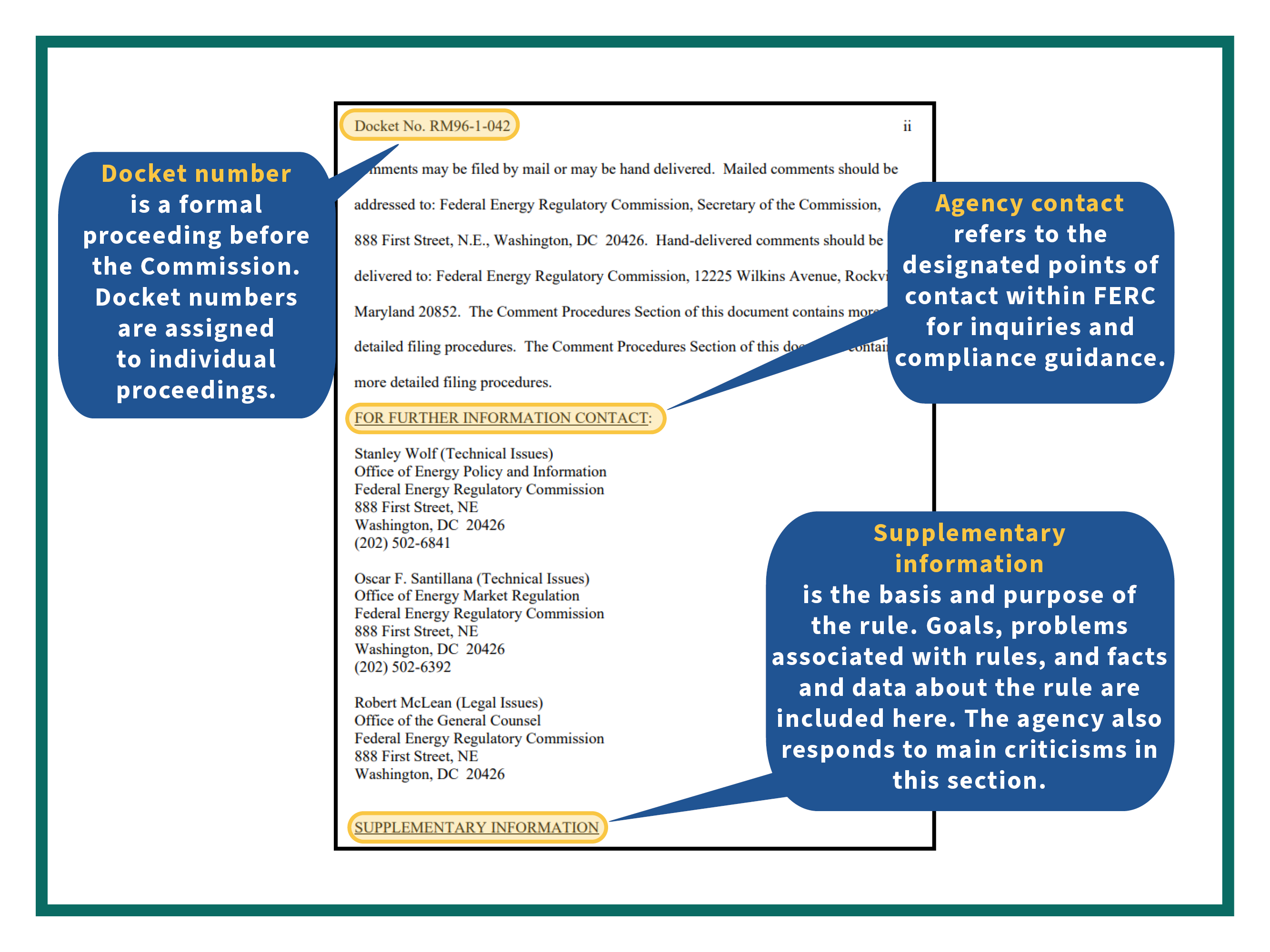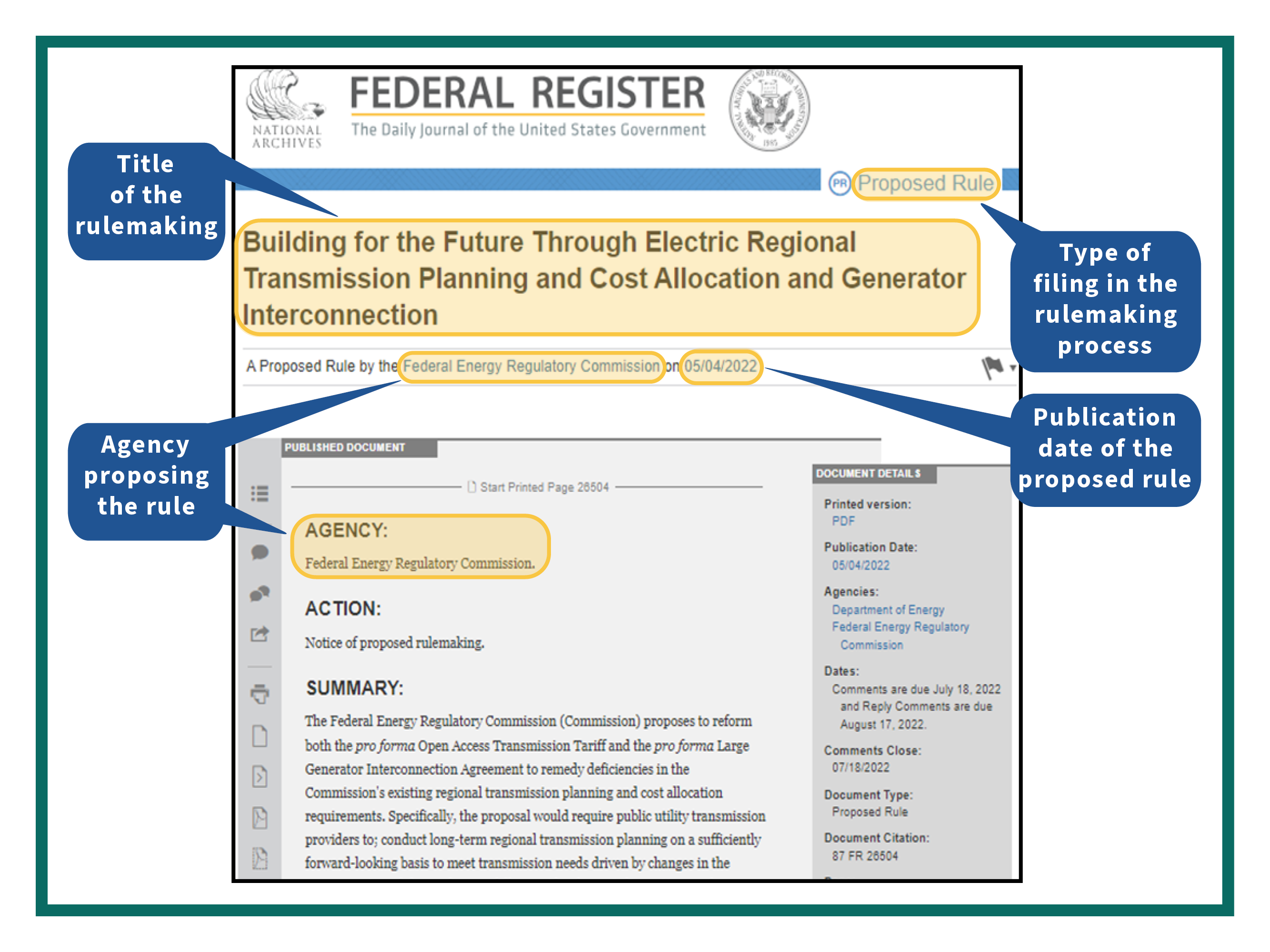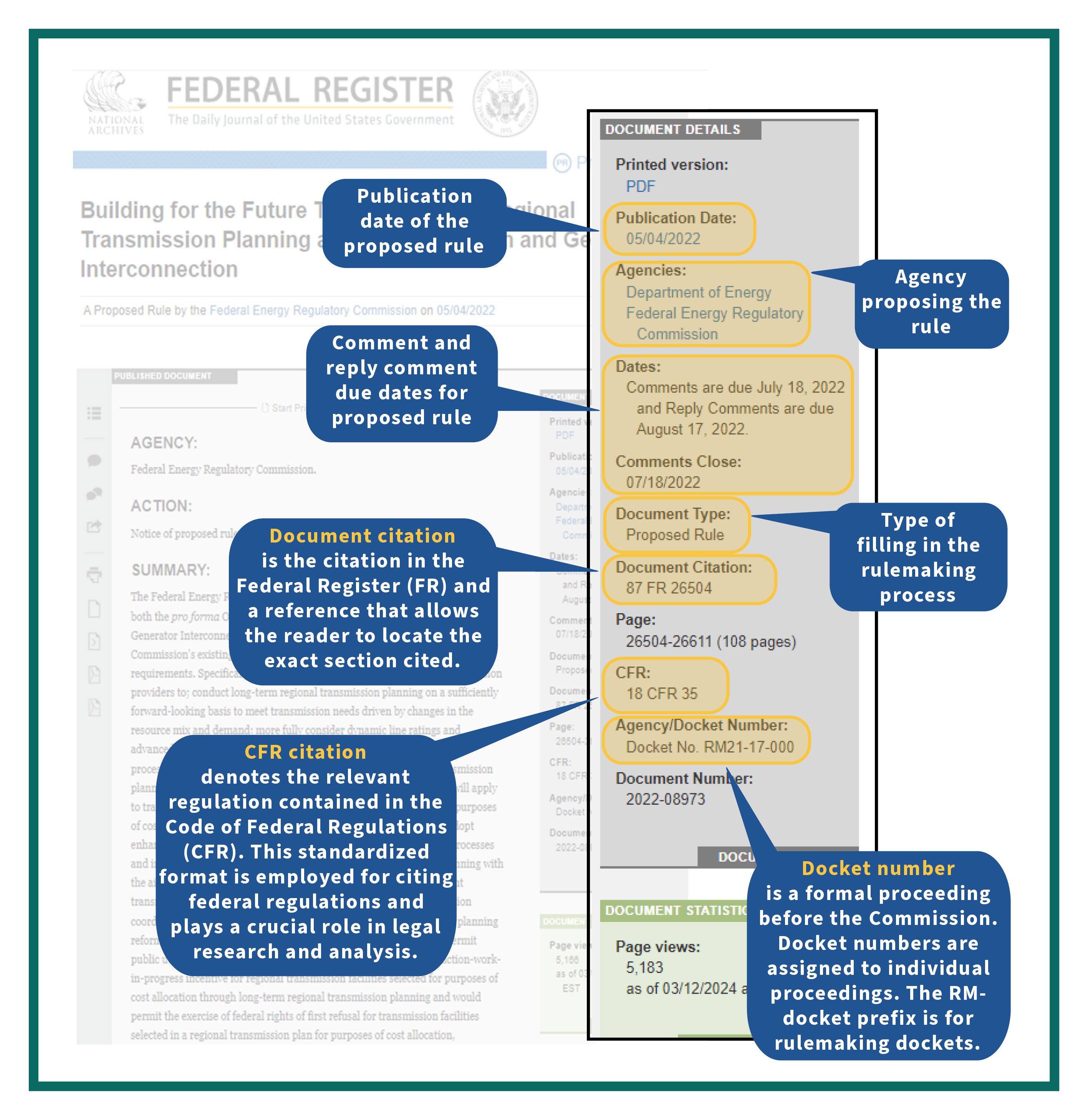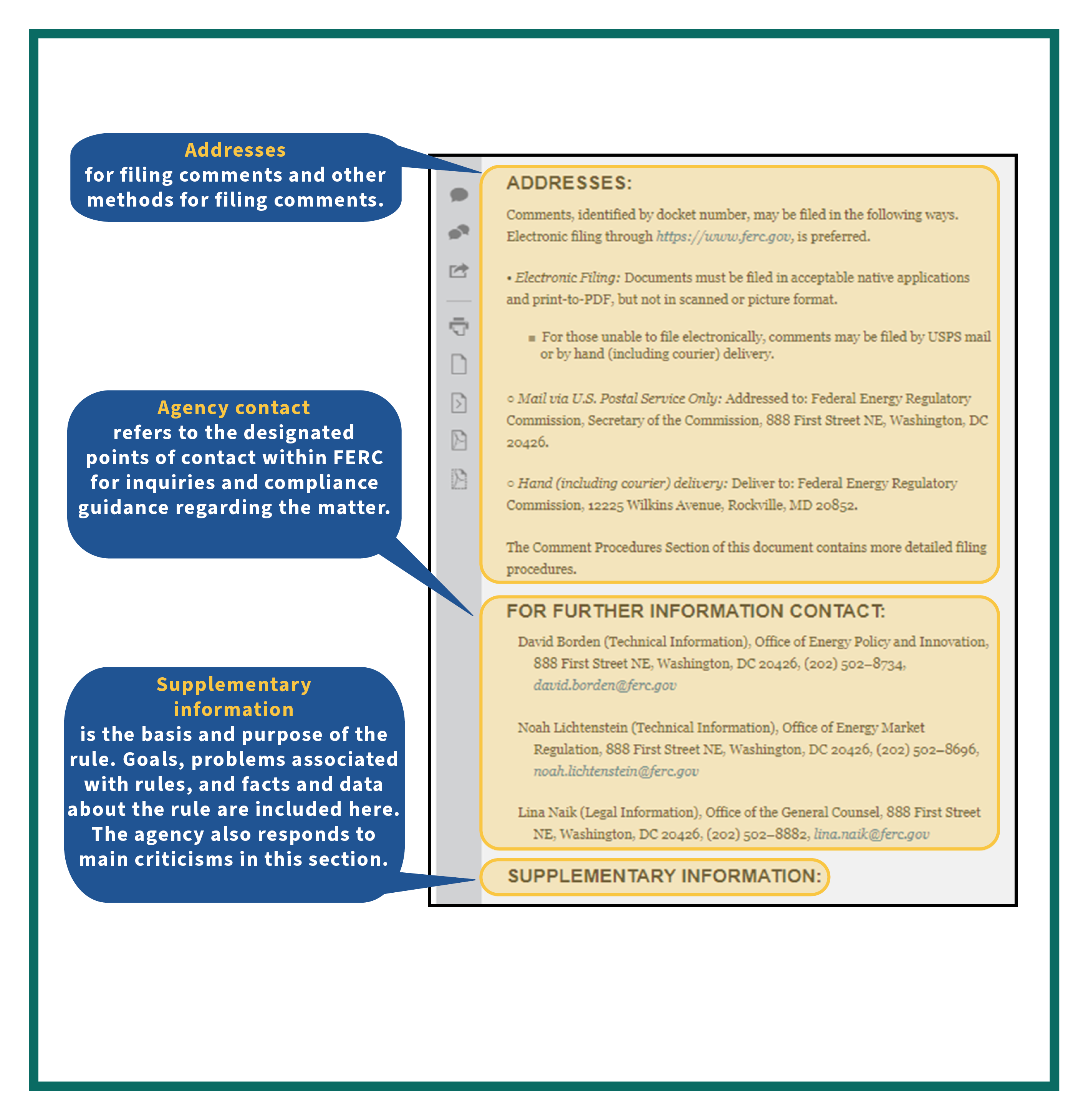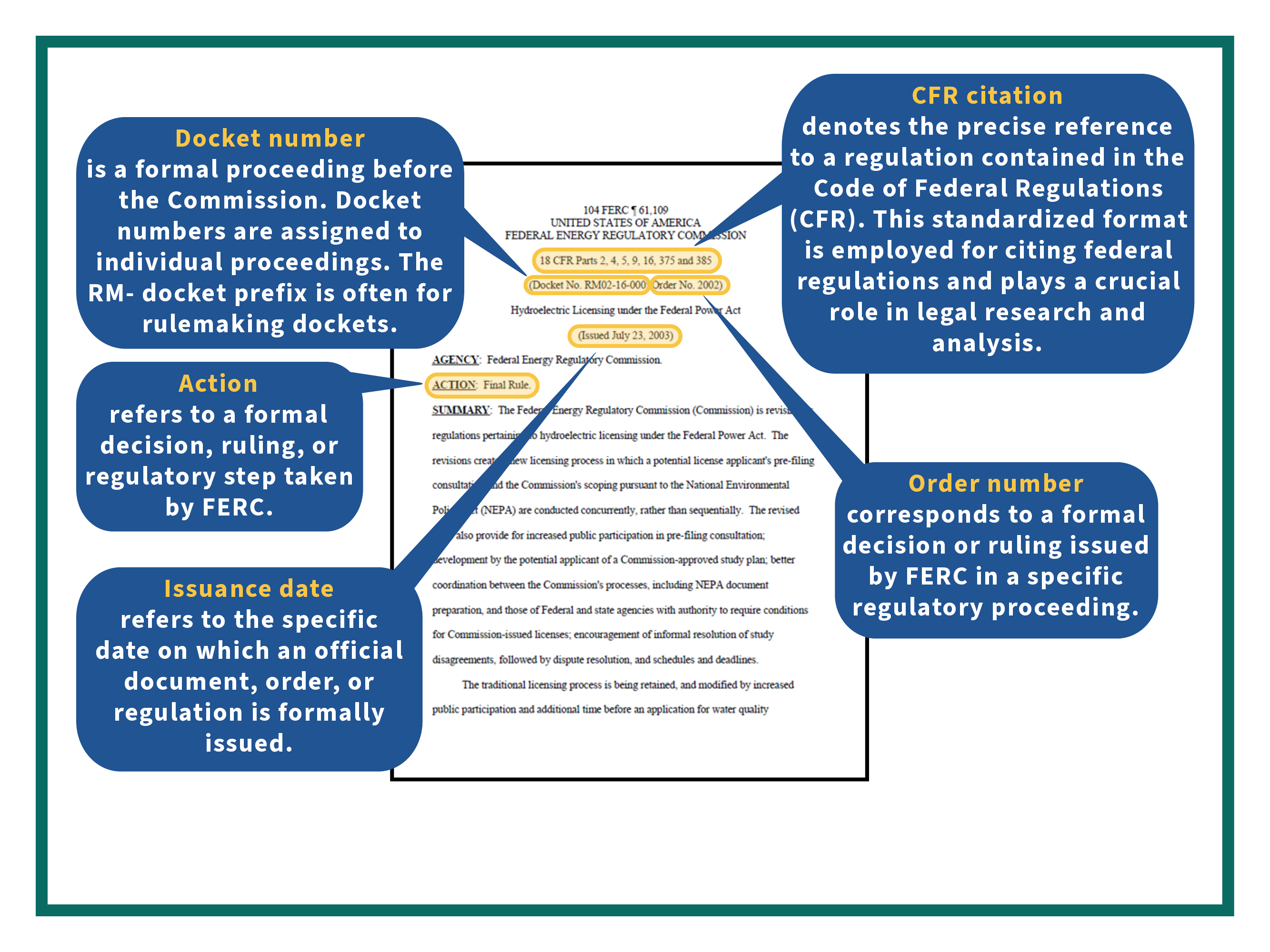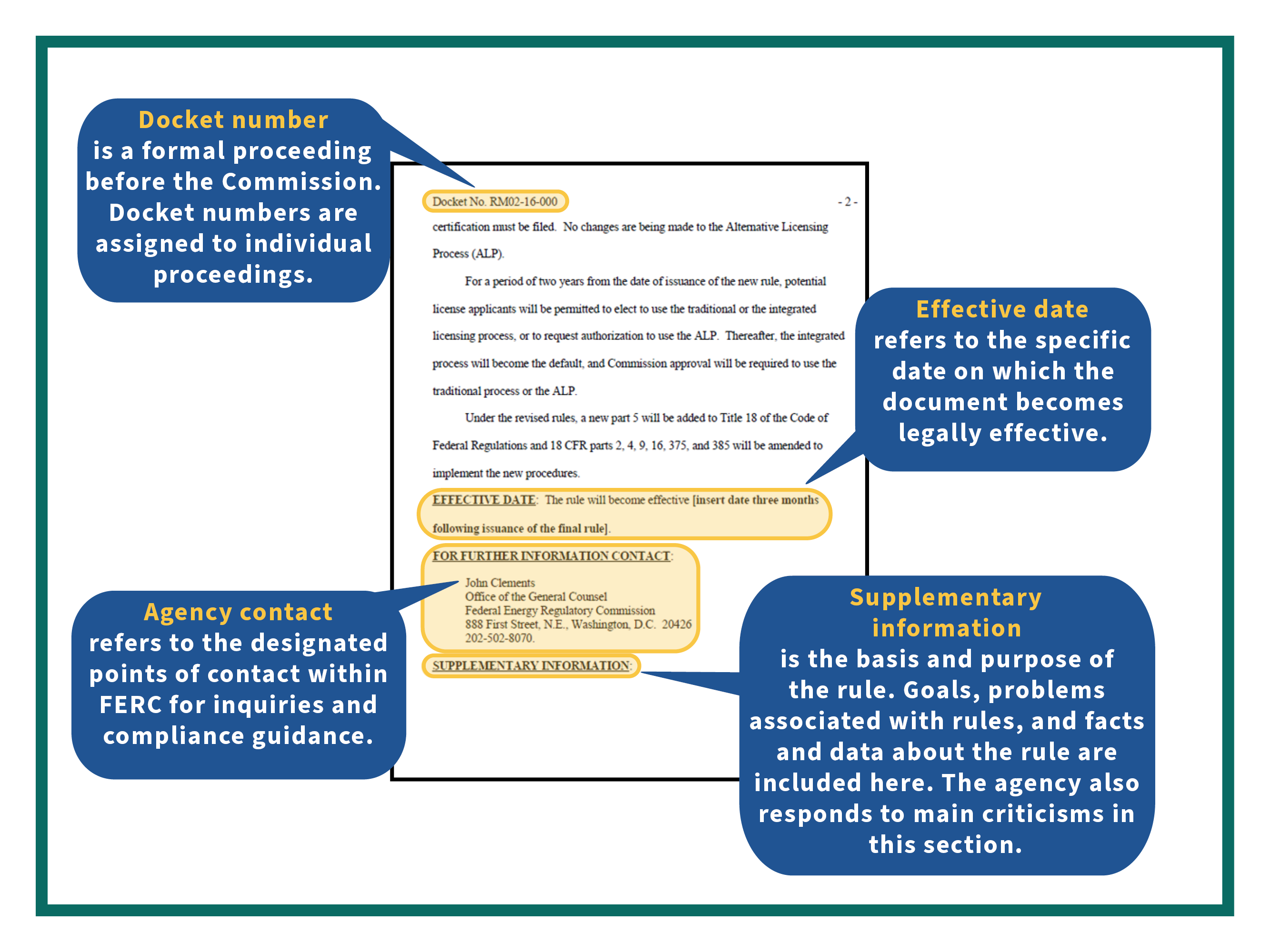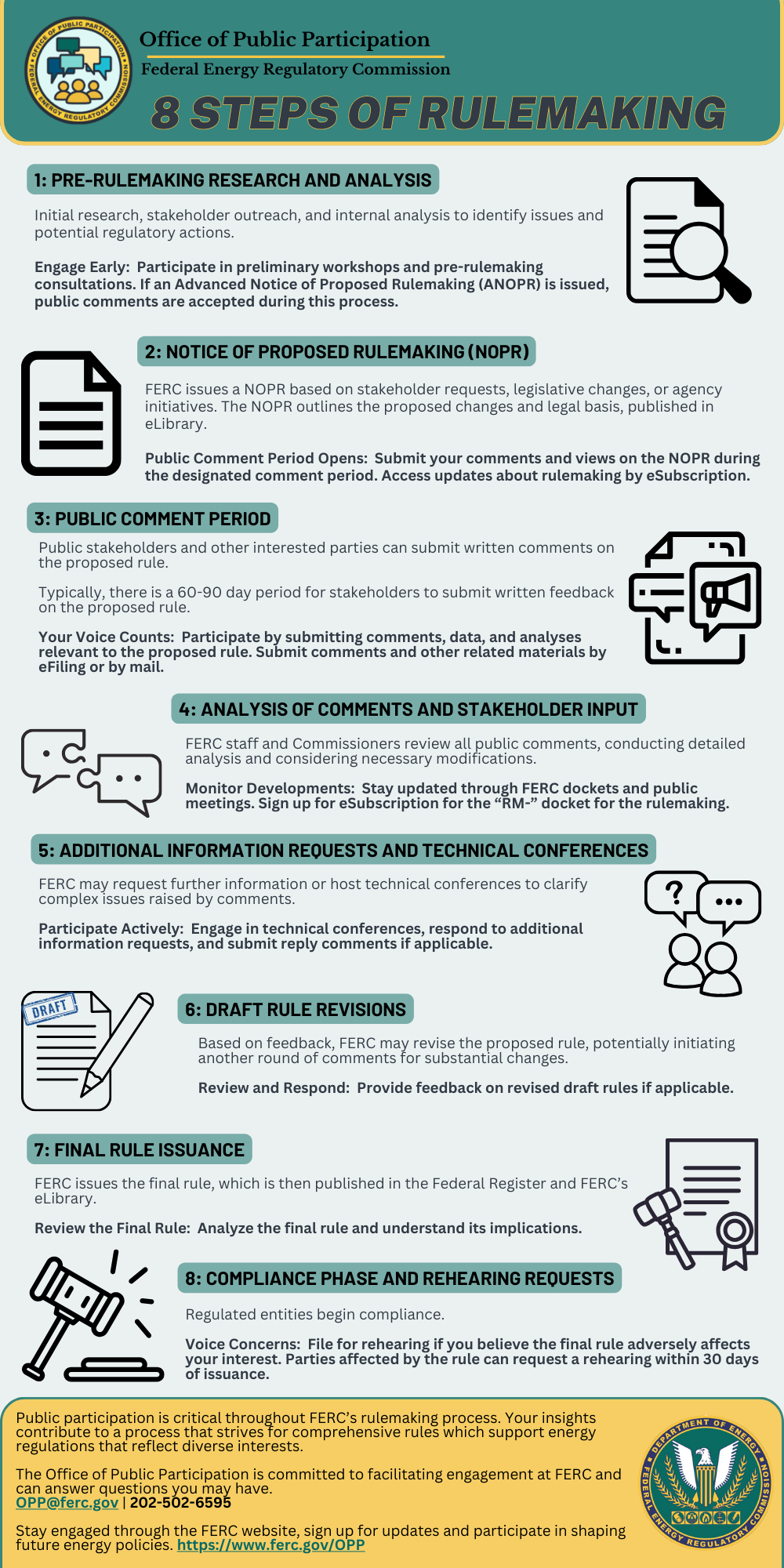Introduction
This explainer offers an overview of the rulemaking process at the Federal Energy Regulatory Commission (FERC). It covers the background of FERC’s authority to make rules, which often includes changes to its regulations, describes the typical rulemaking process, and highlights opportunities for public participation in the process. This explainer will help you understand how to provide FERC with input on the need for new regulations and how to advance your comments and recommendations for modifying existing or proposed rules. You will also learn how to track existing rulemaking processes at FERC that may affect you.
This explainer is organized with seven major sections:
- Key Terms
- How FERC Rulemakings May Affect You and Your Community
- Background
- Key Phases in the Rulemaking Process
- How to Request a Rulemaking
- How to Stay Informed about FERC Rulemakings
- To Learn More
This explainer offers a summary of publicly available information about the rulemaking process and should not be relied upon as a legal document.
Key Terms
The Code of Federal Regulations (CFR) – The official rules and regulations established by various U.S. federal government agencies. These regulations cover a wide range of topics, including safety standards, industry practices, administrative procedures, and legal requirements. The CFR is the foundational reference for legal professionals, policymakers, and anyone seeking to understand and comply with federal laws and guidelines. It provides a structured framework for organizing and accessing the rules that govern different aspects of government operations and public life. Most of the regulations applicable to FERC are the Rules of Practice and Procedure, which are found at 18 CFR Part 385.
Rules – federal regulations, also known as “rules,” are published in the Federal Register and annually updated in the CFR. Rules are established by government agencies, as opposed to laws which are passed by the legislature. The rules help explain laws or policies and describe how a government agency works.
Rulemaking – in the context of the federal government, the term “rulemaking” refers to the systematic process through which federal agencies formulate, amend, or repeal rules and regulations that are subsequently published in the CFR.[1]
Ex Parte Communications – interactions between one party and the decision-making authority without the presence of all other parties. In the context of administrative law, ex parte communications are considered problematic due to potential bias or unfairness. However, rulemaking proceedings at FERC are not subject to ex parte communication prohibitions. While ex parte communications are generally allowed in rulemaking, agencies must still avoid any appearances of impropriety or bias that could undermine the integrity of the rulemaking process.
Notices of Inquiry (NOI) – a formal document issued by the Federal Energy Regulatory Commission (FERC) to solicit public comments on various topics. It’s a key part of FERC’s regulatory activities, ensuring its policies and procedures are current and effective.
Notice of Proposed Rulemaking (NOPR) – a document issued by a federal agency that describes proposed new rules and regulations or proposed changes to existing rules and regulations. FERC issues a NOPR as part of the rulemaking process and, typically, before issuance of a final rule that adopts the proposed changes.
Advance Notice of Proposed Rulemaking (ANOPR) – a document issued by a federal agency to gather input and explore potential reforms before issuing a NOPR.
How FERC Rulemakings May Affect You and Your Community
FERC oversees critical aspects of our nation’s energy infrastructure, including construction and siting of natural gas pipelines, liquefied natural gas export terminals, and hydropower projects. It also regulates the transmission and wholesale sales of electricity and natural gas and the transportation of oil in interstate commerce. FERC decisions can affect the reliability, affordability, and accessibility of energy for households, businesses, and communities. As a member of the public, you should be aware of and understand FERC’s rulemaking proceedings so that you know about potential FERC policy changes that could impact you.
The rulemaking process includes opportunities for members of the public to comment on proposed rules and regulations. These opportunities are one of the most direct and important ways that you can influence federal policy. When a rulemaking seeks to establish new policies and procedures for, say, the interconnection of new power plants, including renewable energy facilities, or to the transmission grid across the nation, the results may impact your daily life, including impacts on the price and reliability of electricity, sustainability goals, among others. By getting involved, you can voice your opinions and ideas about energy policy for your community. Your public comments can shape decisions in FERC rulemakings.
Background
A federal agency’s powers come from laws passed by Congress. For example, for over nearly 100 years, Congress has given authorities and responsibilities to FERC (or its predecessor the Federal Power Commission) under various laws, such as the Federal Power Act, Public Utility Regulatory Policies Act, Natural Gas Act, and Interstate Commerce Act. When Congress passes a new law or amends an old one, it may give federal agencies the power to make specific rules to carry out the work required by the law. The laws passed by Congress also limit the agency's authority to only those actions necessary for implementing its laws. In other words, FERC is a federal agency with key responsibilities but with limited jurisdiction established by Congress. In the context of rulemaking, FERC can only adopt new regulations or policies in its jurisdictional sphere.
The Administrative Procedure Act (APA) sets the rules for how federal agencies can create new regulations. The APA was enacted in 1946,[2] reflecting the growth and increasing responsibilities of federal agencies during that time. Like a rulebook for federal agencies, the APA tells federal agencies how they need to proceed with making new rules that include an open public process.
The APA also sets standards for rulemaking to ensure that the rules are clear, necessary, and consistent with an agency’s legal authority. That is, agencies cannot make any rule they want. They must be able to justify why the rule is needed and show that it is based on sound reasoning. The APA also sets out how these rules can be challenged in court, and many of the APA’s rules and requirements have been refined or clarified through court rulings. This is important because courts provide a check on the power of federal agencies.
In short, the APA, as interpreted by the courts and implemented by FERC, plays a vital role in shaping the rules that impact many aspects of our daily lives, given the central importance of energy. FERC’s rulemaking process is transparent and allows for public input.
Key Phases in the Rulemaking Process
As part of its regulatory function, FERC undertakes rulemaking processes related to many energy industries and activities. The rulemaking process at FERC is designed to be transparent and inclusive, allowing for input from all stakeholders. FERC’s rulemaking process may involve five major phases:
- Petition for Rulemaking
- Preliminary Information Gathering
- Notice of Proposed Rulemaking (NOPR)
- Notice of Final Rulemaking
- Rehearing of Rulemaking
The timeline and procedural requirements for a FERC rulemaking process can vary significantly depending on the complexity of the rule, the number of comments received during any public participation phase, and other factors. Rulemaking is a thorough process often involving multiple stages of review and public comment. It is designed to be comprehensive rather than quick. It’s important to ensure that all relevant factors are considered and that stakeholders have ample opportunity to provide input.
1. Petition for Rulemaking
The rulemaking process may begin with the filing of a petition for rulemaking. This petition may arise from various sources, including representatives from the energy industry or specific companies, non-governmental organizations, or members of the public. The petition outlines the need for a new rule or an amendment to an existing rule.
FERC may choose to move forward with a rulemaking process for a variety of reasons. For example, FERC may consider:
- Whether the petition addresses issues within FERC’s jurisdiction;
- The type of impact a proposed rule or rule change may have on energy markets or infrastructure;
- The extent to which proposed rules align with FERC’s existing regulatory frameworks;
- The urgency and need to address the issues raised in the petition; or
- Alignment of the issues raised with other policy or process goals.
FERC can also independently identify the need to pursue a rulemaking. For example, FERC may see a need for updating its regulations by observing changes in industry, such as an increase in large-scale renewable energy projects or the need for enhanced cybersecurity. In other cases, Congress may enact legislation that directly instructs FERC to establish or revise regulations.
2. Preliminary Information Gathering
A Notice of Inquiry (NOI) is a formal document that FERC may issue to gather public feedback on the necessity of a rule. An NOI is typically one of the first steps in the process and is used to solicit public comment on a wide range of issues, including proposed rules and policies. An NOI describes the proposed rule or policy, the reasons for its consideration, and its potential impacts. It also includes specific questions or areas where FERC is seeking input from stakeholders.
Another way that FERC may solicit input on the need for new rules is through an Advance Notice of Proposed Rulemaking (ANOPR). An ANOPR allows FERC to solicit comments and gauge public interest before initiating a formal rulemaking process. Comments received on an ANOPR can provide information to FERC about how to improve or structure the rulemaking. These comments may suggest the agency not move forward with a rule or may suggest substantive changes to the issues addressed in the rule.
3. Notice of Proposed Rulemaking (NOPR)
When FERC determines that a rulemaking may be warranted, it will issue a Notice of Proposed Rulemaking (NOPR) by publishing the NOPR to both the Federal Register and FERC’s eLibrary system. The NOPR explains the proposed rules in detail, the reasoning for additions or changes, and the potential impacts. The NOPR also contains a draft of any regulatory text that would be added to or revised in the Code of Federal Regulations (CFR). Each NOPR invites public comment on the proposed rule and establishes a comment period.
Figure 1. A screenshot of an NOPR publication in the Federal Register with key elements highlighted: CFR citation, docket number, issuance date, action, and issuance date.
Figure 2. A screenshot of an NOPR publication in the Federal Register with key elements highlighted: docket number, agency contact, and supplementary information.
Through a NOPR, FERC invites comments on the proposed rules and related issues that are discussed in the document. FERC may also hold technical conferences on issues in the NOPR to further expand the record. These technical conferences are typically held in person, but may also be streamed online, are recorded, and have transcripts posted in the rulemaking docket record in FERC’s eLibrary after the event has concluded. Technical conferences provide another venue for an agency to gather feedback about issues under consideration in the rulemaking.
After the public comment period closes, FERC reviews all comments received. FERC considers these comments as it analyzes whether to move forward with its rules or regulations and which proposed changes in the NOPR should be adopted. FERC also decides if it needs to make any further changes. There is no mandatory timeline between when comments are received in response to the NOPR and when the agency may issue a final rule.
As discussed previously, NOPRs are published in the Federal Register and made publicly available online. The public can also access NOPRs, as well as other FERC proceedings and documents in FERC’s eLibrary. For rulemakings, FERC often assigns RM- dockets (e.g., RM24-00-000, RM23-00-000, etc.), and the NOPR’s docket number is used to identify the rulemaking’s record in eLibrary.
Figure 3. A screenshot of an NOPR publication in the Federal Register with key elements highlighted: title of the rulemaking, type of filing, agency proposing the rule, and publication date.
Figure 4. A screenshot of the Document Details section of an NOPR publication in the Federal Register with key elements highlighted: publication date, agency proposing the rule, comment and reply comment due dates, type of filing, document citation, CFR citation, and docket number.
Figure 5. A screenshot of an NOPR publication in the Federal Register with key elements highlighted: addresses, agency contact information, and supplementary information.
4. Notice of Final Rulemaking
After considering all public comments, FERC issues a Notice of Final Rulemaking, or the “final rule.” This notice provides the final version of the rule, along with a preamble that includes responses to public comments and an explanation of any changes made to the proposed rule. The document will also set forth an effective date for the final rule. In the context of a rulemaking, the effective date refers to the specific date when the document becomes legally effective. Many final rules also direct utilities or other regulated entities to submit compliance filings to ensure that their rates, terms, and conditions of service comply with the final rule’s requirements. Those compliance filings result in new, entity-specific dockets that also provide an opportunity for public participation. But, unlike the rulemaking itself, these compliance dockets are subject to FERC’s ex parte communication requirements.
In rare cases, FERC may finalize a rule without first issuing an NOPR. This exception is limited to situations where the agency can demonstrate “good cause” to bypass the notice-and-comment process. Such instances may include emergencies requiring immediate action to protect public health and safety, minor technical amendments or corrections with no substantive impact, and cases where Congress has already mandated a specific regulatory outcome in a law. In that case, FERC would be required to provide its rationale for finding “good cause” in the preamble of the final rule published in the Federal Register.
Figure 6. A screenshot of the first page of a final rule with key elements highlighted: CFR citation, docket number, order number, issuance date, and action.
Figure 7. A screenshot of the second page of a final rule with key elements highlighted: docket number, effective date, agency contact information, and supplementary information.
5. Rehearing of Rulemaking
Once the final rule is issued, members of the public and interested parties have an opportunity for a rehearing of rulemaking. Commenters can seek rehearing within 30 days after issuance of the final rule, pursuant to FERC Rule 713, 18 CFR 385.713. If a person or organization that sought rehearing disagrees with the outcome of FERC’s action on its request for rehearing, the person or organization can file an appeal in federal court. The rehearing process allows for further review and consideration of the rule, and it is possible that there could be multiple rounds of rehearing. Depending on the outcome, a new rulemaking process, a reopening of comments, or other actions may be required.
To learn more about how to file for rehearing, visit FERC’s How to File a Request for Rehearing webpage.
Summary of the Key Phases of FERC’s Rulemaking Process
The rulemaking process at FERC is designed to be transparent and inclusive, allowing for input from all members of the public and interested parties. It ensures that all rules are carefully considered and reviewed before they are implemented.
The timeline for the FERC rulemaking process can vary significantly depending on the complexity of the rule, the number of comments received during the public participation phase, and other factors. Please note that rulemaking is a thorough process often involving multiple stages of review and public comment. It is designed to be comprehensive rather than quick. It’s important to ensure that all relevant factors are considered and that stakeholders have ample opportunity to provide input.
Figure 8. 8 Steps of Rulemaking infographic.
How to Request a Rulemaking
The process of requesting a rulemaking, also known as submitting a petition for rulemaking, is a way for people or organizations to suggest changes to existing rules or propose new ones within FERC’s jurisdiction. To create and submit a petition, there are seven key steps:
- Identify the Issue. Indicate the issue or problem with an existing rule or a need for a new rule.
- Research. Conduct thorough research on the issue, including whether the issue is within FERC’s jurisdiction. Understand the existing rules related to the issue and why they seem lacking. Doing so will help in making a strong case for the proposed rule change. Remember that agencies must justify why a final rule is needed based on sound reasoning.
- Prepare the Petition. Clearly state the action you want the agency to take in the petition. It should include the text or substance of any proposed rule or amendment, or it should specify the rule or portion of a rule requested to be repealed. It should also include a statement of your interest and reasons for requesting the action. As you are preparing the petition, you can, but are not obligated to, reach out to FERC staff to discuss the issue you’ve identified, the concerns you intend to raise, and the solution you plan to propose. FERC staff might be able to provide helpful feedback before you file.
- Submit the Petition. File the rulemaking petition online electronically through FERC’s eFiling system and by U.S. mail, or hand delivery. FERC does not accept rulemaking petitions by email.
- Monitoring. Keep track of the petition as it is under FERC’s review. There is no required timeline for FERC to address a petition for rulemaking and make a decision. FERC may take no further action on the petition, may issue an order on the petition, may gather more information relevant to the petition, or may decide to move forward with the rulemaking process. To stay informed, subscribe to the docket on FERC’s eSubscription service.
- Public Comment: If FERC decides to proceed to an NOI, ANOPR, or NOPR based on your petition, a period for public comment will open. This is an opportunity for you to further support your petition by submitting comments in favor or opposition to the proposed rule. The public comment period is usually between 60-90 days but can be shorter or longer. Members of the public and interested parties can request additional time to file comments.
- Final Rule: After considering all public comments, FERC may issue a final rule. Like ANOPRs and NOPRs, final rules are published both in the Federal Register and in FERC’s eLibrary.
Although this process may take time and there is no guarantee that FERC will respond to your petition, requesting a rulemaking remains a crucial way for the public to participate in the rulemaking process.
How to Stay Informed about FERC Rulemakings
The easiest way to track a specific rulemaking is to sign up for FERC’s eSubscription service. A subscription provides emailed notifications on information about FERC specific rulemakings (i.e., issuances of rulemaking, notices about technical conferences, final rules, etc.), as well as comments or other filings made in the rulemaking docket. Most rulemaking dockets at FERC will have the prefix “RM” in the docket number. Select the RM- docket for the rulemaking you want to receive updates about. Depending on how active the rulemaking is, you may receive many emails about the docket.
Additionally, federal agencies are required to publish a list of rulemakings in their “Unified Agenda” every spring and fall. Unified Agendas include a “Regulatory Plan” that is published in the fall and an “Agenda of Regulatory and Deregulatory Actions” that is published in the spring. The Unified Agenda allows you to learn about potential FERC rulemakings, as well as updates about ongoing and completed FERC rulemaking dockets. To access a list of FERC’s Unified Agenda as required by the rulemaking process, visit reginfo.gov’s Unified Agenda webpage and, under “Select Agency,” find and select the “Federal Energy Regulatory Commission.”[3] You can also access the Unified Agenda by visiting the Regulatory Agenda on regulations.gov and selecting “Federal Energy Regulatory Commission (FERC)” under the “Select Agency” drop menu.
FERC maintains a list of landmark and major orders on its Major Orders & Regulations webpage. This page includes rulemakings about various issues and industries FERC regulates, issued throughout the years.
To Learn More
Please contact FERC’s Office of Public Participation (OPP) by e-mail at [email protected] or by phone at (202) 502-6595. OPP’s website also provides additional information and resources about this process.
To find explainers on rulemakings currently open before FERC, visit OPP’s Educational Handouts webpage and navigate to the section titled “Rulemakings” under “Explainers.”
[1] For more information on the rulemaking process, see the Office of the Federal Register’s A Guide to the Rulemaking Process, Federal Communications Commission’s Rulemaking Process webpage, Congressional Research Service’s “An Overview of Federal Regulations and the Rulemaking Process” article, and U.S. Government Accountability Office’s Federal Rulemaking webpage.
[2] For a brief summary of the history of the APA, APA’s judicial review requirements, and APA’s scope, see Congressional Research Service’s “Judicial Review Under the Administrative Procedure Act (APA)” article.
[3] Please note, however, that FERC may issue rules on matters not listed in the Unified Agenda and, conversely, FERC reserves the right not to act on an item that is listed in the Unified Agenda. Since FERC acts through majority votes of Commissioners, FERC cannot always predict which rulemaking proceedings will occur or be completed in a given period.


